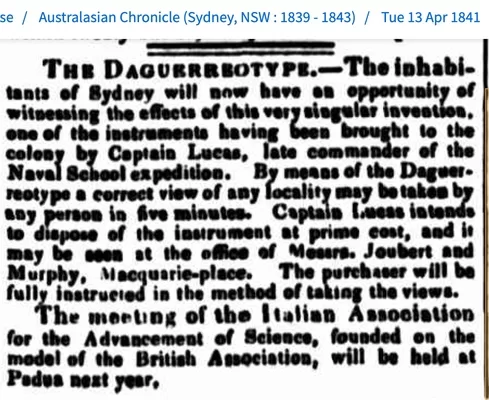Captain Augustin Lucas (1804-1854), a visiting French naval officer, is credited with capturing the first photograph in Australia in 1841. His daguerreotype of Bridge Street in Sydney marked the beginning of the photographic journey in the country. No copies of Captain Lucas’ streetscape photograph are known to exist.
The historic event was reported in the Australasian Chronicle dated 13 April 1841.




Left: The record of the first photograph using a Daguerreotype in Australia, 1841.
Right: Not the Lucas photo, an undated glass negative photo of Bridge Street, Sydney, possibly turn of the century.
THE DAGUERREOTYPE. — The inhabitants of Sydney will now have an opportunity of witnessing the effects of this very singular invention, one of the instruments having been brought to the colony by Captain Lucas, late commander of the Naval School expedition. By means of the Daguerreotype a correct view of any locality may be taken by any person in five minutes. Captain Lucas intends to dispose of the instrument at prime cost, and it may be seen at the office of Messrs. Joubert and Murphy, Macquarie-place. The purchaser will be fully instructed in the method of taking the views.
Bridge Street in Sydney was not chosen at random to become the first photograph to be made in Australia. At the time “Bridge Street had become the place to live“, and “the elite of the colony chose to establish properties” there.
Joubert and Murphy, representatives for French ships in Sydney who engaged in the trade of wine and food, facilitated the sale of Lucas’s camera. The first documented image, now lost to history, was created on or near their establishment situated in Macquarie Place, which offered a view of Bridge Street.
French educational voyage
Captain Lucas arrived in Sydney at the end of March 1841 on the ship Justine. Lucas had previously served as the captain of a educational vessel, L’Oriental, backed by the French ‘Societé d’Encouragement pour l’Industrie Nationale’ (SEIN). This educational ship had embarked on an extensive journey, circumnavigating the globe with a cohort of 54 students, several professors, the captain’s wife, children, and a dedicated crew.
L’Oriental embarked on its journey from France in early October 1839, merely a month following a lecture delivered by Daguerre at the SEIN offices in Paris. This lecture comprehensively outlined his groundbreaking photographic process, an account of which was subsequently published in the SEIN journal.
Aboard L’Oriental was Abbot Louis Comte, who served as the ship’s chaplain and music instructor. Notably, he achieved the distinction of becoming the first person to demonstrate the daguerreotype process in the southern hemisphere when the ship made a stop in Rio de Janeiro. Subsequently, Abbot Comte disembarked in Montevideo, Uruguay, where he established a daguerreotype studio.
Shipwreck of L’Oriental
L’Oriental faced a harrowing shipwreck along the Chilean coast shortly after departing from Valparaiso. Fortunately, both the cargo and the crew were successfully rescued. Regrettably, this marked the conclusion of the educational voyage for the vessel.
Captain Lucas continued his journey to Australia aboard the ship Justine, which was under the command of his younger brother, Captain Francois Lucas. He carried with him a daguerreotype camera and related equipment obtained from L’Oriental.
The first Daguerreotype arrives in Australia
The entrepreneurial Captain Lucas brought his Daguerreotype camera to Australia intending to sell his camera and equipment. He displayed the latest technological marvel from Europe in the office of Messrs. Joubert and Murphy on Macquarie Place for prospective buyers.
Lucas’s intention was to sell the camera in Sydney, and he organized at least one public demonstration of its use. Although the newspaper article detailing this appeared in April, according to researcher Rupert Derek Wood, the first officially documented daguerreotype wasn’t captured until a month later, precisely on May 13, 1841.
Joubert and Murphy, who served as Sydney agents for French ships and engaged in the trade of various goods, including wine and food, seemingly agreed to help Lucas sell the camera. The initial known photograph, which regrettably no longer exists, was taken on or near their premises in Macquarie Place and depicted a view of Bridge Street.
Lucas left Australia just a few weeks after taking this photograph, embarking on a vibrant seven-year trade mission in Tahiti. During this time, he might have even had the opportunity to use a camera again, given that the French Admiral who assumed control of the region in 1842 had brought a camera with him from Paris. Lucas eventually returned to France in 1848 but soon left his homeland for America, where he passed away around 1854.
Surprisingly, the demonstration of photography in Australia did not seem to greatly impress the public. The camera remained unsold even two years later, prompting Joubert’s decision to return to Europe.
Eventually, the firm’s assets were auctioned off. It is possible that this unsold camera was the one later reported to have been purchased by Hobart photographer Thomas Bock from “an impecunious Frenchman” in 1843.
Mr. Bock went on to supplement his portrait painting business in Van Diemen’s Land with his daguerreotype camera, earning the wrath of George B Goodman (credited as being the colony’s first professional photographer) and became a pioneer of photography in the colony.
Rupert Derek Wood, through meticulous research, has contributed significantly to filling in the finer details of this narrative. Wood is a photography historian of some note, also writing Calotype Patent Lawsuit of Talbot v.Laroche, 1854 and J.B. Reade, F.R.S., and the early history of photography and The involvement of Sir John Herschel in the photographic patent case, Talbot v. Henderson, 1854.
Further reading
Related stories:
Australia’s First Professional Photographer George B Goodman
The Oldest Surviving Daguerreotype In Australia, 1845
Guide to Collecting Vintage Film Cameras
Glossary of photography terms for auction & collectors – with examples
FEATURE: Collecting Old & Vintage Photographs
Life Magazine’s Innovative Photography at MFA Boston
NASA’s Famous Blue Marble Photo Is 50 Years Old
Man Ray’s love-hate relationship with Hollywood
Fake Photo: Manipulated photography before Photoshop
Faked photos for Soviet propaganda
The beginning of photography: heliographs and daguerreotypes






